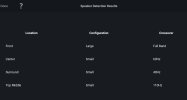Follow-up: What if LCR is rated till 80Hz, surrounds are rated till 110 Hz and Atmos even higher?
Of course, I'll play around and see. But where does one set the crossover, generally, when it comes to speakers that skim the bottom?
Will a speaker rated at 80Hz fully let go of its responsibility there, or is there some room to work around?
Most sub manuals say set the sub 10Hz above what the main speakers 'can truly do'. Now, do we take specs at face value or add a dash of salt?
Regards
Of course, I'll play around and see. But where does one set the crossover, generally, when it comes to speakers that skim the bottom?
Will a speaker rated at 80Hz fully let go of its responsibility there, or is there some room to work around?
Most sub manuals say set the sub 10Hz above what the main speakers 'can truly do'. Now, do we take specs at face value or add a dash of salt?
Regards


